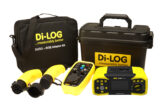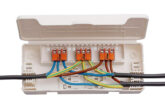
Mike Cullom, Sales Manager for Northern Europe at Ideal Industries, gives a detailed breakdown of the different types of test meters and highlights the key features electricians should look for when buying test equipment tools.
Electricians invest a substantial amount of money into the tools they use every day on the job site, so it’s important that they do their research and buy tools that are specifically appropriate to their line of work. The Ideal range of testers and meters is segmented into tools for commercial, domestic and apprentice use, enabling customers to easily source the right product for their specific requirements.
The part numbering system makes it easy to identify the right tester. The base model has the lowest number while the higher functioning/higher CAT rated testers have a higher part number; for example the entry point non-contact voltage tester is 61-627, the next model up is 61-637, and so-on.
Since meters can be simple diagnostic tools that accurately quantify voltage, amperage, and continuity, they’re used by almost every electrician in almost every setting. When combined with the specialised knowledge electricians possess, they can help test, install and repair electrical components of various capabilities and complexities.
Meters can easily determine if faults exist, verify proper circuit functionality, and can actively assist in keeping infrastructure up and running. Most importantly, they help prevent unsafe conditions, not only for the customer, but for the electrician working on the circuit.
Each potential buyer must consider their work environment as being the biggest factor in making a purchase – not only now, but in the future. Since these tools can be expensive, they should be considered an investment and treated as such.
Residential electricians may pick something completely different than an electrician who plans on working on high current outdoor industrial applications. Each role may require a different tool.
Meter types include:
Multimeter
These meters are used for everything from small electronics applications to battery testing and continuity assessments. They often provide a higher degree of range, resolution and functionality than clamp meters.
Fork meter
A two-pronged “fork” fits around the conductor and takes a current measurement without interfering or breaking the circuit. This is particularly useful in lower current (100 to 200 A) cramped or limited access situations.
Clamp meter
A retractable clamp fits around the conductor that is being measured allowing isolation from other conductors. This is more suited to applications in which conductor isolation is necessary, and for higher current applications.
Non-contact voltage tester
A speciality meter that is typically only useful in situations where only the presence of voltage is being sensed, to indicate the possibility that a circuit is energised or not. These testers simply verify the existence of electricity in a particular circuit or conductor. Non-contact voltage testers do so without any physical contact with the conductors and can be a complementary tool. However, most instructors discourage this as being a primary tool.
WHAT THE PROFESSIONALS USE
Most professional electricians don’t bother using any meter in the field that is less than a CAT III. Many wouldn’t even begin to consider a meter that doesn’t hold a True RMS rating.
A well appointed, TRMS-rated CAT III clamp or fork meter is useful in a broad range of environments (battery, small electronics, all residential work, service, agricultural, and light industrial). They are typically the easiest to manipulate and are safe and robust.
For a full list of categories of meters you’ll see on the market and features worth looking for, check out the Ideal T&M buyer’s guide.
Safety first
One of the most obvious benefits of choosing the correct meter is safety. In high current applications, a clamp or fork meter is clearly less risky to use than a multimeter that uses probes, as it is not necessary to break the circuit to take a current measurement. There is always a potential for an arc flash when interrupting a circuit, so using a meter that doesn’t require a circuit interruption is not only ideal, but also much safer.
Favourite features
When asked, seasoned professionals will all mention their favourite features in meters. Having had the opportunity to speak with industry pros, we got a variety of answers, including:
Battery life
For obvious reasons, this is an important aspect of a meter. You don’t want to be on a jobsite with a non-functional piece of equipment.
Alert/Tone technology
An audible notification is crucial in certain environments that are dimly lit, or just from an ease-of-use perspective. Many meter manufacturers offer this feature. Often, it is possible to defeat the tone in noise sensitive areas such as hospitals.
Clear display
Being able to see your reading accurately in challenging workplaces is critical. Single or dual displays that are legible are extremely important regardless of where your job site may be.
Heavy duty
Although meters are precision instruments, they must be tough and durable. Many manufacturers rate their meters to easily survive a 2m fall. Some offer a rubber overmould that helps with both insulation and drop protection, in addition to helping with grip and ergonomics.
Certifications
Professionals typically buy their gear as a lifetime investment. Most of the reputable manufacturers certify their meters to be accurate and test them prior to leaving the factory, as well as providing some sort of warranty. Some even offer third-party certifications (such as a UL Listing) to ensure their accuracy, safety, and longevity.
One-handed design
A good meter is ergonomically comfortable and can be used with one hand. Some meters allow both storage of the leads on the back and some will hold the extended probe or probes to simplify your work. This is useful in a variety of situations, whether you are a lineman, industrial, commercial, or residential electrician.
Browse the IDEAL T&M Catalogue here









